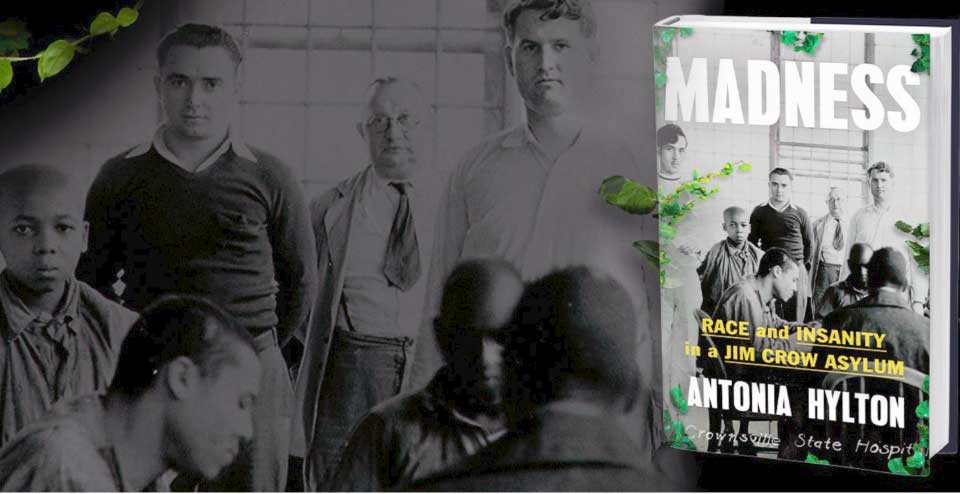
Award-winning journalist Antonia Hyldon’s new book Madness might work, if it weren’t entirely factual, as the premise of a Jordan Peele horror film.
In 1911, twelve Black men were ordered to build the first structure for what would become the Maryland Hospital for the Negro Insane. They were that asylum’s first patients. Within a year, hundreds of Black men and women, many without diagnosed illnesses, some with developmental disabilities, and others the victims of a violent, racist criminal injustice system, were sent to the hospital located near Crownsville, Maryland, a rural district close to the capital city of Annapolis. Medical care was rarely the goal of their incarceration; many never survived life at the hospital.
Usually characterized as inmates rather than as patients, the hospital’s inhabitants were often physically abused, punished with isolation, undernourished, and subjected to overcrowded conditions. They were typically forced to work with no pay in the hospital’s workshops, making baskets and other items that the hospital sold to pay the expense of their imprisonment. Otherwise, they cultivated hundreds of the hospital’s farming acres or were leased to local plantations for routine agricultural work. Hyldon describes such conditions as “slavery by another name.”
The hospital’s founders believed that emancipation had sparked a massive rise in mental illness among African Americans. Freedom, they deceitfully contended, had proven to be disastrous for Black people who were racially predisposed to be healthiest and happiest under white people’s control. Many were individuals who might otherwise have been deemed healthy but were caught in a racist system and had become a “captured labor force.” Conditions at the asylum were so horrendous that by 1920, ninety-eight of the patients died while only twenty-eight of several hundred were deemed recovered enough to be released. Only two doctors were assigned to provide medical care for the entire hospital.
Later renamed Crownsville State Hospital, its patients suffered from decades of overcrowding, underfunding, forced unpaid labor on neighboring farms, neglect, and abuse. Throughout most of its existence, state health authorities ordered that children with developmental disabilities be mixed there with adults with varying diagnoses, including being labeled “criminally insane.”
White doctors and poorly trained attendants believed that Black mental health patients should be managed through work and incarceration. Many patients went undiagnosed and untreated, while others had been court-committed to relieve overcrowded jails. The most famous instance, perhaps, of this latter was the “Elkton Three.” Three Black civil rights activists, Juanita Nelson, Wallace Nelson, and Rose Robinson, were court-committed to Crownsville for refusing to cooperate with the cops after being arrested for attempting to desegregate a truck stop along Maryland’s infamously violent Route 40 in 1961.
At times, historical narrative, journalism, and personal memoir, this soul-stirring book also documents the many acts of love committed by Black men and women who came to work at Crownsville after the desegregation orders of the 1950s.
Unforgettable is Gertrude Belt, one of the hospital’s first Black attendants, who broke protocol when she held patients carefully to bathe them and comb their hair for the first time in decades. White attendants refused to touch Black patients, except to punish them, and scorned the idea that they should regularly and safely clean hospital facilities, acts that resembled domestic service. This book documents a century of complex intertwining of systemic racism, mass incarceration, and views of mental illness.
Pages of detailed descriptions of lynch mobs in Maryland’s Eastern Shore, just across the bay from Crownsville, are contrasted with numerous accounts of Black men and women who sought to provide care for the asylum’s patients. Hyldon’s investigations of the hospital’s records at the Maryland State Archives proved fruitless, providing limited perspectives on the lives of the thousands of men, women, and children who stayed there.
Instead, her relationships with former employees and their families helped uncover the untold stories. Articles and reports from the Baltimore Afro-American and NAACP investigations revealed the violence, abuse, neglect, and horrors of the place before the 1950s. The image they drew revealed the place to be a racist “dungeon.”
The hospital’s history reveals the madness of Jim Crow. State authorities and Euro-Americans generally demanded racial segregation. In addition, they demanded that mentally ill Black people should never receive the same funding for professional services and facilities they needed to be made whole. Instead, they created conditions of incarceration and abuse that proved horrific to Black patients as well as dangerous for Euro-American workers at the hospital. Indeed, the wretched conditions provided no sense of safety for local communities who always feared dangerous “escapees.” Racist attitudes and perceptions shaped their periodic demands for more walls and locks, never for more professional care and healing for people who were their neighbors.
In the 1950s, Euro-American Marylanders strongly resisted Supreme Court orders to desegregate Crownsville’s public facilities, including schools, conveyances, and public spaces. Demands to hire Black attendants, medical staff, and doctors were brushed aside. At the same time, state officials insisted (without a sense of irony) that Black staff would be automatically underqualified and unable to care for patients as well as white staff. Eventually, people like Dr. Vernon Sparks, Gertrude Belt, Dr. Jim Ballard, Thomas Arthur, and Dorothea McCullers––among many other attendants, nurses, and doctors––joined the Crownsville staff and pioneered a new direction of care.
They were enabled by Dr. Jacob Morgenstern, a Jewish-American refugee of the fascist atrocities in Central Europe, who must have identified close comparisons between what he found at Crownsville and Nazi policies. Hyldon’s tribute to Morgentern’s courage and interventions is a moving supplement to her detailed accounts of Black (and occasional Euro-American) caregivers who tried to counter decades of violence and hatred that had infused the hospital’s work and structure. Belt and McCullers, for example, sought to restore dignity and care for the patients and led clothing and blanket collection drives to provide patients with something other than meager coverings mandated by the hospital.
Around the 1960s, mental health care and related public policies dramatically changed. President Kennedy, moved by his own family experiences, sought to establish a network of federally-funded, state and local community health centers that would eliminate the major hospital systems and provide direct and holistic care for people with mental illness and developmental disabilities. The premise was good, but the reality was still dominated by systemic racism and an emergent neoliberal schema of eliminating public services to enable capitalist accumulation. Hyldon shows both the social and mental health consequences of deindustrialization and neoliberal policies for Black people. In the end, the racist panic that criminalized Black people fueled the crisis of racist mass incarceration.
Here, Hyldon delivers a critical insight: before the turn toward mass incarceration in the 1970s, Black people in disproportionate numbers were institutionalized in mental hospitals, where they were assigned to forced labor regimes and other kinds of abuses. After the prison boom in the 1970s, the populations of jails and prisons exploded with large numbers of Black and Latino imprisoned people. Meanwhile, the number of Euro-Americans who were directed into non-carceral forms of mental healthcare services grew radically. In other words, at the precise moment the mental health care field began to show us that care, holistic services, and medicine were critical elements of restoring a person to health, white people were showered with new resources. Black people with mental health problems were simply consigned to prisons and jails and, in worst-case scenarios, victims of police killings in ever-growing numbers.
This hybrid of historical research, journalist fact-finding, and personal memoir deserves to be discussed and studied. Its mixture of story-telling and clear-sighted analysis delivers truths about U.S. society that we need to hear and talk about, especially in the dangerous era of fascist resurgence led by former president Donald Trump and the MAGA movement.
Madness: Race and Insanity in a Jim Crow Asylum
Antonia Hyldon
New York, Hachette Book Group, 2024
ISBN: 9781538723692










